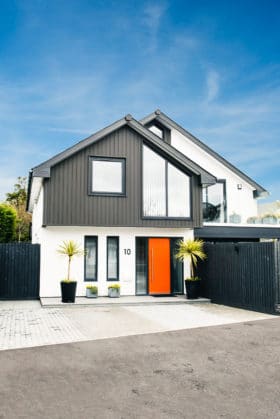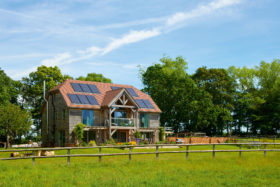
Sign up to our virtual training course today!
Use code BUILD for 20% off
Sign up to our virtual training course today!
Use code BUILD for 20% offDavid and Pia England’s self build journey began in 2007, when they purchased two rural cottages and a rundown steading on a 23-acre sheep farm. The pair had been on the lookout for a conversion opportunity for almost three years when they discovered this site near Aberfeldy in Perthshire.
“My wife had just given birth to our second child when I heard about the farm. It was a bit further north than we’d looked before,” says David. “We bundled the baby up and piled into the car; it was one of those beautiful blue-sky days. When we arrived, my mother-in-law immediately told me I had to try and buy the place.”
The vendor was keen to sell the property in one block, which comprised the steading, two cottages and a farmhouse. But fate was on the Englands’ side. David raised enough finance to buy everything except the farmhouse, which another buyer put in an offer for.
“The owner decided to go ahead with splitting the farm, but it was a nervous couple of days waiting to hear whether it had gone through.”
Fast forward almost 10 years, and the Englands had accomplished the refurbishment of both cottages and the conversion of the steading. However, by this time, David was keen to tackle a self build project that would allow him to work with a completely blank canvas.
“It was the excitement of creating a new dwelling where I’d be able to decide exactly how I could have the shape, the design, the glazing and everything else,” he says.
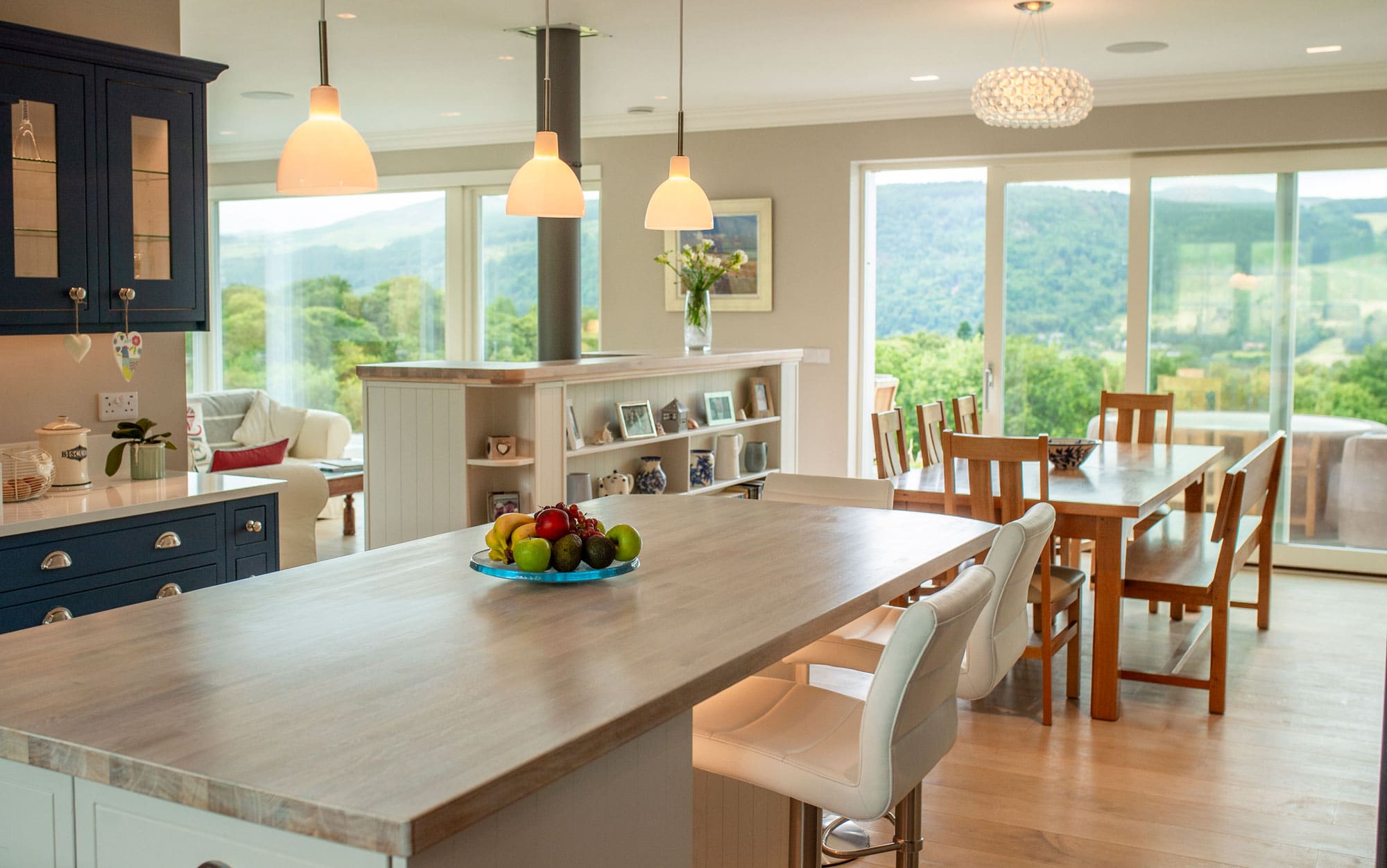
The open-plan interiors offer a bright and spacious feel, forming a sociable zone that complements day-to-day family life
Little did the couple know when they first visited the farm in 2007, that a spot close to the entrance of the property was to be the site of their future home.
“The outlook on that side is stunning,” says David. “I was brought up on a farm in Perthshire; I loved the open views.”
David decided the time was right to seize the opportunity. Luckily, the Englands are good friends with John Langley of JML Contracts and had worked with the firm on previous projects. John introduced the couple to architect Colin Potter.
“Our initial conversations with Colin grew arms and legs,” says David. “To cut a long story short, a year later we had planning consent for a five-bedroom house about 200m from where we’d just converted the steading.”
When it came to drawing up the design for the new abode, David sourced his inspiration largely from the site itself. “The number one thing was to capture the panoramic views to the north, but also to get the sun from the south,” he says.
Another priority was to create a building with traditional appeal that was firmly rooted in the characterful aesthetic of the existing farm.
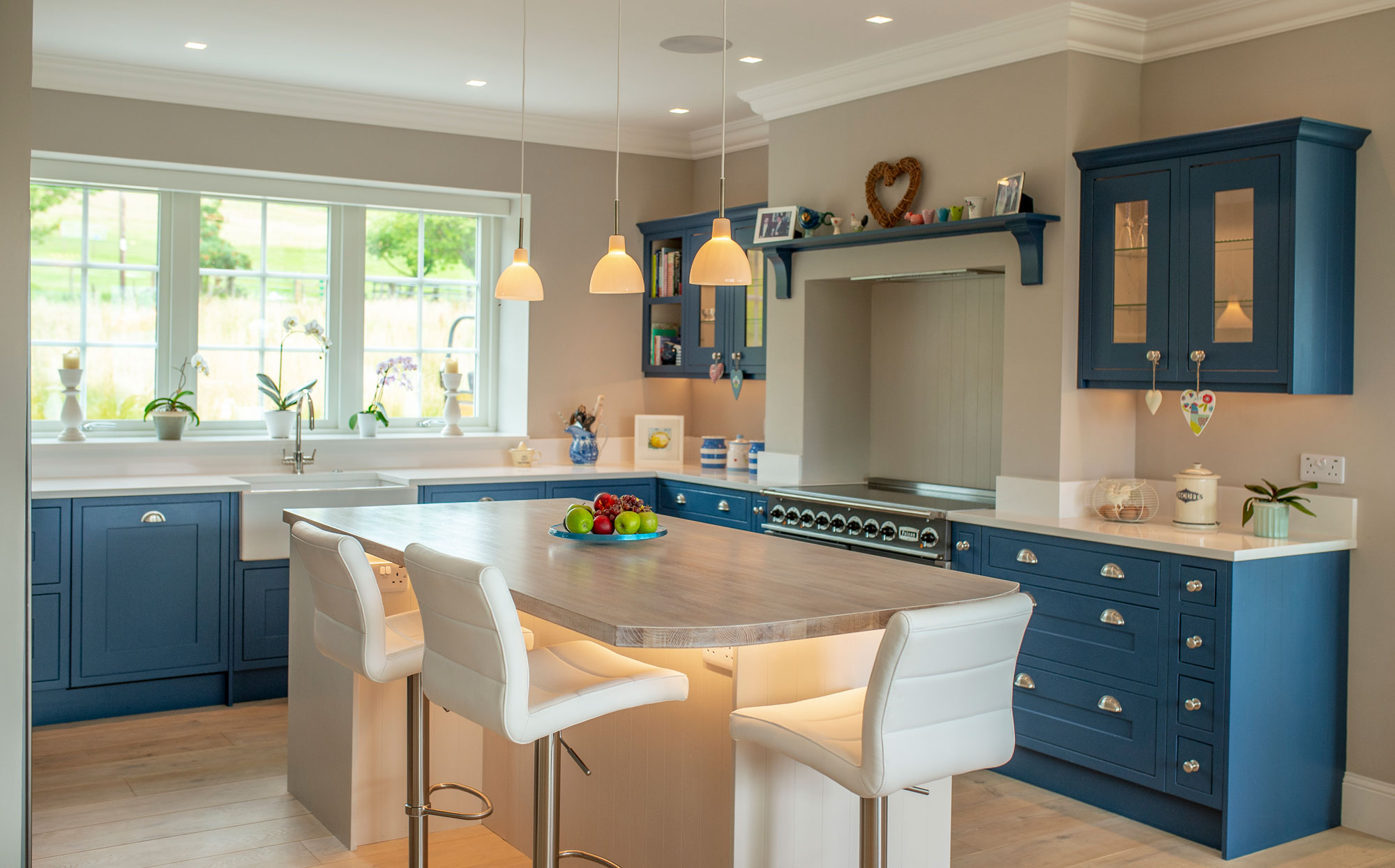
Striking blue cabinetry has been paired with bright white quartz worktops. The kitchen island functions as a central hub for the culinary zone
“I didn’t want a white Hollywood box with a flat roof,” says David. “My wife has quite traditional taste, too. She’s Swedish, and even though a lot of Scandinavian design is associated with being fairly modern, we both wanted something with a characterful exterior. My hope is that in 100 years’ time, the house will still look the part.”
The design the Englands submitted to planning made it through the process without any significant revisions. “Colin took care of that side of things for us, and actually had a meeting on site with the officer handling our case,” says David.
“It’s always a smart move to engage an architect that has a good track record of gaining planning permission in the local area, and Colin had done work in Perthshire before.”
When it came to selecting a build method for the house, David was automatically drawn to SIPs (structural insulated panels), thanks to the system’s energy efficiency and thermal performance.
“I also liked the fact that we wouldn’t need to have a huge amount of structural steel,” he says. “We had required a lot of it in our previous conversion of the steading. I liked the fact that, by using SIPs, the extra support wouldn’t be necessary.”
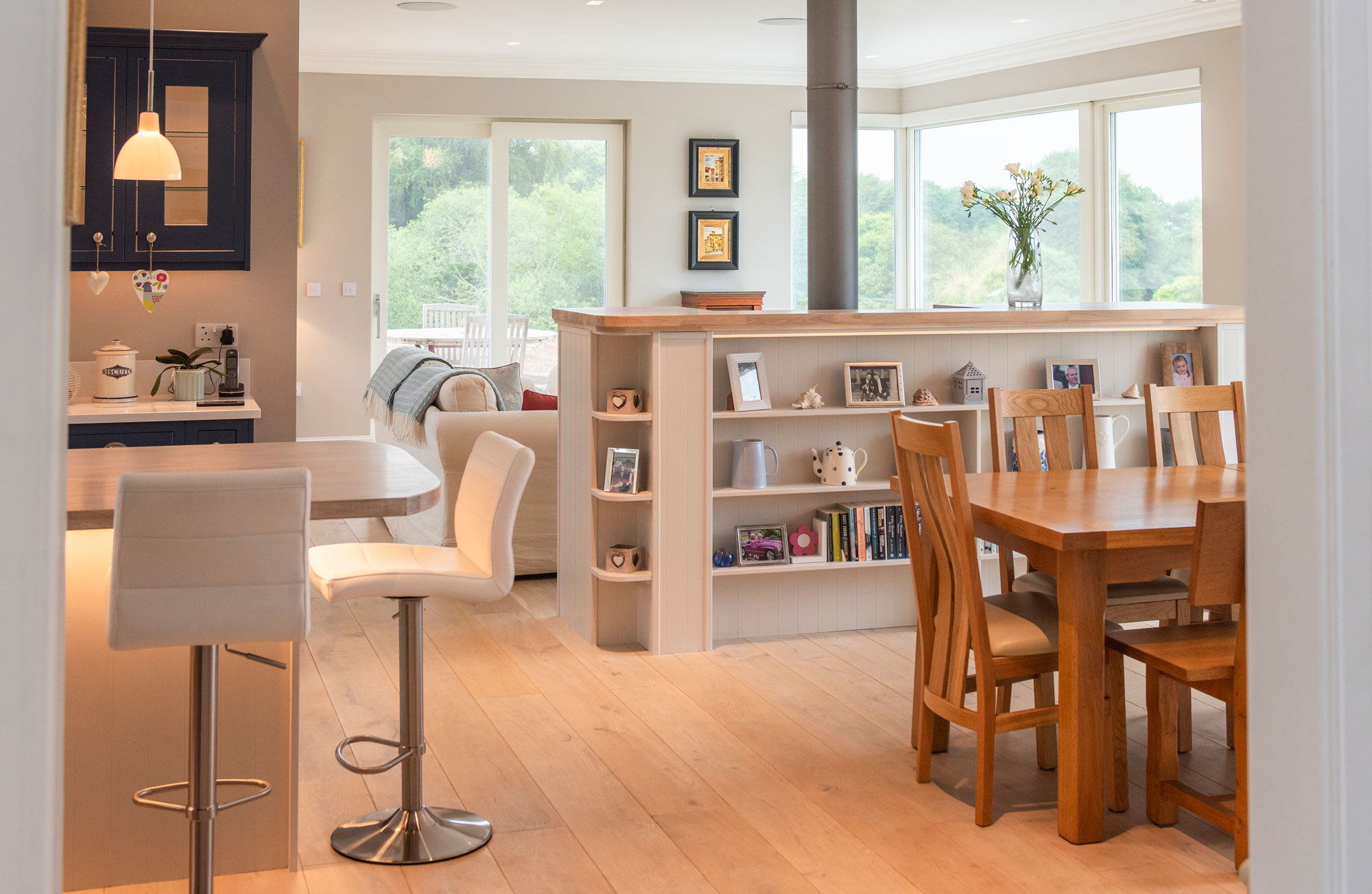
Engineered oak flooring has been laid throughout the kitchen-living-dining area, and broad swathes of glazing take in the spectacular views
While David was set on a fairly contemporary construction technique for the house, some of his material choices were more on the traditional side. Stone that was already on the farm was re-used to clad various portions of the new property. This is complemented by spans of fibre cement cladding, which is laid in horizontal boards.
Creating a highly airtight structure was a key priority for David, so triple glazed windows were installed throughout.
Establishing a heating setup that was sustainable and energy-efficient was another important goal. “I looked at biomass boilers, but after several conversations with the experts, it was clear the heat output would be too great,” he says. “In the end, we went for a Nibe air source heat pump, which performs really well.”
A mechanical ventilation and heat recovery (MVHR) system was also installed. This extracts heat from stale air to be expelled from the house, before introducing warmth into the fresh supply. “It was quite a challenge when it came to channelling all the ducts down to the plant room, as each pipe has a fairly thick diameter and they all need to come into one place,” says David.
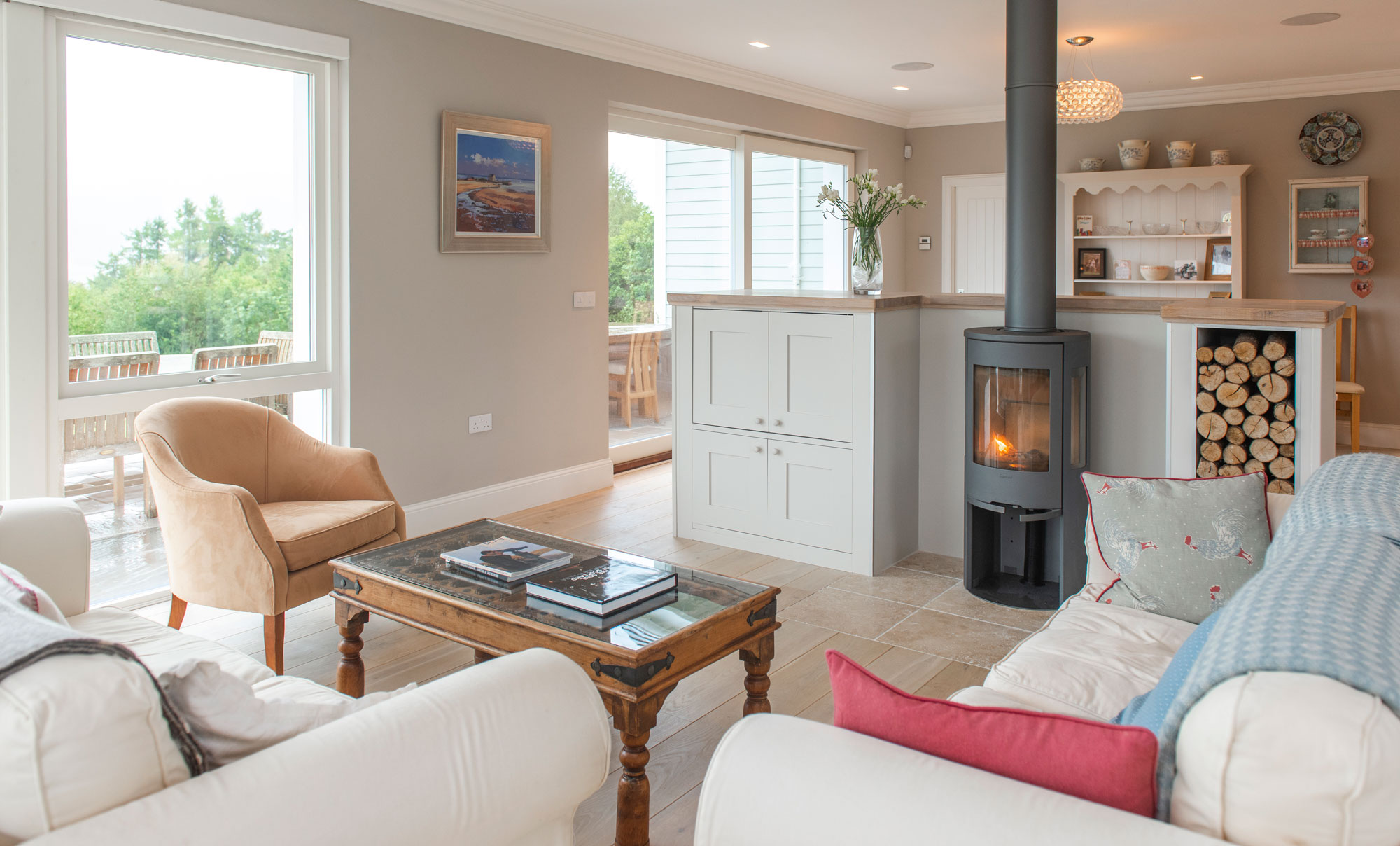
A contemporary woodburner provides an attractive focal point in the sun-drenched living room, enhancing the cosy feel of the space
“Suddenly, your ceiling height gets encroached upon because you’ve got to find a way to fit them all in. The space had to be very well designed to pack everything in.” The MVHR system complements the underfloor heating (UFH), which has been laid throughout the downstairs and in the upstairs bathrooms.
Five radiators are positioned in the first-floor bedrooms to provide an extra blast of warmth when needed.
With a selection of home improvement projects already under his belt, David opted to take on the role of project manager himself. For the first portion of the build, from foundations until after the house was wind and watertight, David would check in with JML Contracts – the lead contractor – every day.
“We had purchased and were living in the farmhouse by that point, so every morning I’d stop and chat to the JML’s site foreman,” says David. “Checking in every day really made a difference. He made sure I was thinking three or four weeks ahead in terms of materials, and he’d let me know if there were any issues that needed to be resolved.”
Once the shell was complete and the underfloor heating installed, David took over the site management and sourced the remaining specialists himself.
“I still had 12 trades to sort out; I ended up spending much longer on site. Often, it was two or three hours in the morning, at the same time as taking work calls and emails,” he says. For David, this was the most challenging part of the project. “Completing the last 5% – the internal fitout – was really fiddly. It’s all about attention to detail. Installing the winding balustrade for the staircase was particularly tricky, as it was quite intricate to put together. The joiners were pulling their hair out on that one!”
Looking back on the project, David recalls the erection of the SIPs kit as one of the highlights of the project. “It was great seeing where the house was going, knowing where the windows would be and how everything sat on the land,” he says.
“The bit that was the most hassle was definitely the last 10% of the build. It certainly doesn’t take up just 10% of the time.”
While the exterior of the house oozes traditional charm, the interiors are bright, spacious and contemporary. Broad swathes of glazing are one of the major features, framing stunning views of the rural outlook. In terms of the decor, the Englands opted for a neutral palette to keep things simple and bright.
“We wanted to design something that was easy on the eye, but different from the creamy shades we went with in the steading conversion,” says David, whose favourite place is the sun-soaked living room. They have laid oak engineered flooring throughout much of the ground floor, adding a characterful warmth.
WE LEARNEDDURING THE PLANNING process, put yourself in the case officer’s seat. Try and understand what the council has got to do within their remit, as all local authorities have certain strategies they’re working within. Talk to the planners and try to understand what it is that they want and will allow so that you can put something which meets their criteria. WHEN THINGS GO WRONG on site, you’ve got to try and work your way through it by communicating with the trades you’ve hired. It doesn’t help to fall out with anyone. Of course, there were plenty of little things that annoyed me as the project progressed, but you have to move past these obstacles. BE A SPONGE You can never have too many conversations with people, both before and during the project. You can always learn more, whether it’s through friends or by chatting to professionals in the industry. SUBSCRIBE TO MAGAZINES like Build It and read them thoroughly. I discovered some of my suppliers – Solarcrest MVHR and HardiePlank cladding – that way. |
“I like the softness of the surface,” says David. In the hallway and boot room, however, travertine tiles have been laid as a durable, yet aesthetically pleasing finish.
“The kitchen is a little more modern this time, as we went for a white quartz worktop and blue units,” David says. “It was quite a big decision getting the shade of the cabinetry exactly right. You need to specify something you can live with.”
In terms of gadgets, the instant hot water tap in the culinary zone is another one of David’s favourite features. He also loves the Sonos sound system that pipes music throughout the property.
“We’ve got six or seven zones in the house,” he says. “Our three young children absolutely love it. They’ve got the Sonos control app and it gives them the flexibility to listen to what they want, wherever they are in the house.”
Now the build is complete, David has no major regrets. “In hindsight, we made a couple of mistakes – but nothing big,” he says. “There’s one switch I already want in a different place, because the kids always leave a certain light on!”
And this serial home improver has started eyeing up his next scheme. “We’ve got a plot in Sweden we’d like to build something on one day, but that would be more of a summer house,” he says.
“If we ever did move, it’d be difficult for me to find somewhere that lives up to the property we’ve created here. You get a bit spoilt – I designed and built this home for my family, tailored it to our needs, and we love the way it works for us.”
